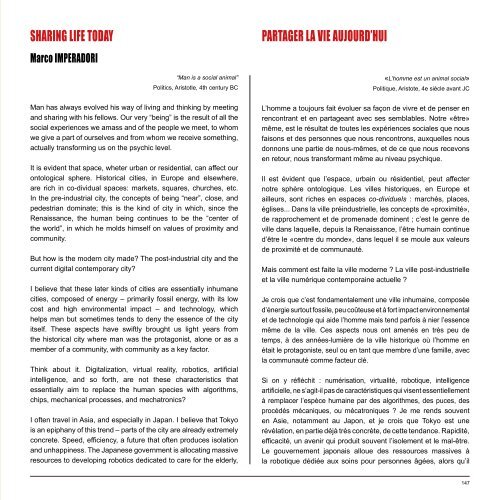What is Co-dividuality?
ISBN 978-3-86859-621-2
ISBN 978-3-86859-621-2
- No tags were found...
Create successful ePaper yourself
Turn your PDF publications into a flip-book with our unique Google optimized e-Paper software.
SHARING LIFE TODAY<br />
Marco IMPERADORI<br />
PARTAGER LA VIE AUJOURD’HUI<br />
“Man <strong>is</strong> a social animal”<br />
Politics, Ar<strong>is</strong>totle, 4th century BC<br />
«L’homme est un animal social»<br />
Politique, Ar<strong>is</strong>tote, 4e siècle avant JC<br />
Man has always evolved h<strong>is</strong> way of living and thinking by meeting<br />
and sharing with h<strong>is</strong> fellows. Our very “being” <strong>is</strong> the result of all the<br />
social experiences we amass and of the people we meet, to whom<br />
we give a part of ourselves and from whom we receive something,<br />
actually transforming us on the psychic level.<br />
It <strong>is</strong> evident that space, wheter urban or residential, can affect our<br />
ontological sphere. H<strong>is</strong>torical cities, in Europe and elsewhere,<br />
are rich in co-dividual spaces: markets, squares, churches, etc.<br />
In the pre-industrial city, the concepts of being “near”, close, and<br />
pedestrian dominate; th<strong>is</strong> <strong>is</strong> the kind of city in which, since the<br />
Rena<strong>is</strong>sance, the human being continues to be the “center of<br />
the world”, in which he molds himself on values of proximity and<br />
community.<br />
But how <strong>is</strong> the modern city made? The post-industrial city and the<br />
current digital contemporary city?<br />
I believe that these later kinds of cities are essentially inhumane<br />
cities, composed of energy – primarily fossil energy, with its low<br />
cost and high environmental impact – and technology, which<br />
helps man but sometimes tends to deny the essence of the city<br />
itself. These aspects have swiftly brought us light years from<br />
the h<strong>is</strong>torical city where man was the protagon<strong>is</strong>t, alone or as a<br />
member of a community, with community as a key factor.<br />
Think about it. Digitalization, virtual reality, robotics, artificial<br />
intelligence, and so forth, are not these character<strong>is</strong>tics that<br />
essentially aim to replace the human species with algorithms,<br />
chips, mechanical processes, and mechatronics?<br />
I often travel in Asia, and especially in Japan. I believe that Tokyo<br />
<strong>is</strong> an epiphany of th<strong>is</strong> trend – parts of the city are already extremely<br />
concrete. Speed, efficiency, a future that often produces <strong>is</strong>olation<br />
and unhappiness. The Japanese government <strong>is</strong> allocating massive<br />
resources to developing robotics dedicated to care for the elderly,<br />
L’homme a toujours fait évoluer sa façon de vivre et de penser en<br />
rencontrant et en partageant avec ses semblables. Notre «être»<br />
même, est le résultat de toutes les expériences sociales que nous<br />
fa<strong>is</strong>ons et des personnes que nous rencontrons, auxquelles nous<br />
donnons une partie de nous-mêmes, et de ce que nous recevons<br />
en retour, nous transformant même au niveau psychique.<br />
Il est évident que l’espace, urbain ou résidentiel, peut affecter<br />
notre sphère ontologique. Les villes h<strong>is</strong>toriques, en Europe et<br />
ailleurs, sont riches en espaces co-dividuels : marchés, places,<br />
égl<strong>is</strong>es... Dans la ville préindustrielle, les concepts de «proximité»,<br />
de rapprochement et de promenade dominent ; c’est le genre de<br />
ville dans laquelle, depu<strong>is</strong> la Rena<strong>is</strong>sance, l’être humain continue<br />
d’être le «centre du monde», dans lequel il se moule aux valeurs<br />
de proximité et de communauté.<br />
Ma<strong>is</strong> comment est faite la ville moderne ? La ville post-industrielle<br />
et la ville numérique contemporaine actuelle ?<br />
Je cro<strong>is</strong> que c’est fondamentalement une ville inhumaine, composée<br />
d’énergie surtout fossile, peu coûteuse et à fort impact environnemental<br />
et de technologie qui aide l’homme ma<strong>is</strong> tend parfo<strong>is</strong> à nier l’essence<br />
même de la ville. Ces aspects nous ont amenés en très peu de<br />
temps, à des années-lumière de la ville h<strong>is</strong>torique où l’homme en<br />
était le protagon<strong>is</strong>te, seul ou en tant que membre d’une famille, avec<br />
la communauté comme facteur clé.<br />
Si on y réfléchit : numér<strong>is</strong>ation, virtualité, robotique, intelligence<br />
artificielle, ne s’agit-il pas de caractér<strong>is</strong>tiques qui v<strong>is</strong>ent essentiellement<br />
à remplacer l’espèce humaine par des algorithmes, des puces, des<br />
procédés mécaniques, ou mécatroniques ? Je me rends souvent<br />
en Asie, notamment au Japon, et je cro<strong>is</strong> que Tokyo est une<br />
révélation, en partie déjà très concrète, de cette tendance. Rapidité,<br />
efficacité, un avenir qui produit souvent l’<strong>is</strong>olement et le mal-être.<br />
Le gouvernement japona<strong>is</strong> alloue des ressources massives à<br />
la robotique dédiée aux soins pour personnes âgées, alors qu’il<br />
147


















